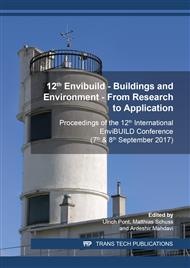p.587
p.597
p.605
p.613
p.622
p.633
p.641
p.650
p.659
Comparison of the Energy Performance of a Heat Pump under Various Conditions by Using a Hardware-in-the-Loop (HIL) Test Method
Abstract:
For nearly Zero Energy Buildings, it is a challenge to optimize the heat supply of the building based on technologies like heat pumps. Within the project “energy4buildings” a test bench has been realized to create an interface between hardware, located in a laboratory, and a building simulation software. This integrated test bench with a focus on electrical driven heat pumps and chillers can be used to simulate realistic conditions like part load behavior, stand-by-losses, on/off behavior or user-/weather conditions by using different kind of building models. The requirements of the test rig have been realized by using a hardware-in-the loop (HIL) method, which allows real-time tests of embedded devices within a virtual environment under reproducible laboratory conditions. By using the HIL-method, early statements according performance with a reduction of costs under realistic conditions can be made for various devices. This paper describes the implementation of the HIL-interface consisting of hardware, simulation software and data acquisition including an optimization of the behaviour of the control system as well as HIL experiments at varying steady state conditions like temperature tolerance or holding time. Based on the tests both, a comparison of the performance and analyses of deviations between real and simulated value have been made, to make an accurate statement of the behaviour of the system. The knowledge gained in this paper indicates a potential for optimization of the control strategy of some components as well as the improvement of the communication process to make an early estimation regarding performance of the installed device.
Info:
Periodical:
Pages:
622-632
Citation:
Online since:
January 2019
Authors:
Keywords:
Price:
Сopyright:
© 2019 Trans Tech Publications Ltd. All Rights Reserved
Share:
Citation:


